Stanley Boxer: The Ribbon Paintings (1971-1976) Gallery Tour
December 3, 2021 - Berry Campbell
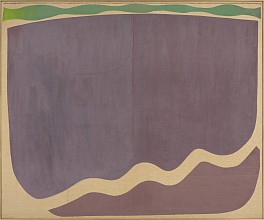
December 3, 2021 - Berry Campbell
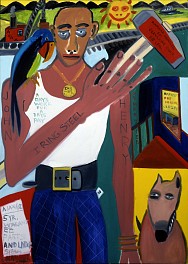
November 25, 2021 - Jackie Lupo for The Rivertowns Enterprise
The Hudson River Museum is presenting an important survey exhibition, “African American Art in the 20th Century,” that was organized by the Smithsonian American Art Museum and includes 43 objects from their permanent collection.
The show, on display through Jan. 16, 2022, presents paintings and sculpture by 34 African American artists who became famous in the decades between the Harlem Renaissance and the civil rights movement. The works reflect the artists’ responses to the evolving international aesthetic movements of the 20th century, as seen through the lens of race in America. As one of these artists, Jacob Lawrence, said in 1951, “My pictures express my life and experience… the things I have experienced extend to my national, racial and class group. I paint the American scene.”
HRM director and CEO Masha Turchinsky called the Smithsonian’s collection “one of the most significant national collections of African American art. This is a pivotal opportunity for the public to experience powerful works by these American luminaries at the exhibition’s only New York venue.”
The African American experience as shown by these artists embraced both rural and urban life.
In 1940, William H. Johnson, a native of South Carolina, painted “Sowing” in oil on burlap. He used brilliant colors and the naive style characteristic of many of his paintings of country life in the South in the early 20th century.
But the rural South could also be inhospitable for Black people. At first glance, Norman Lewis’ 1962 “Evening Rendezvous” seems largely abstract. Blink, and a sinister scene appears: a crowd of white-hooded Klansmen milling around a red-hot fire. According to the Smithsonian’s label for this painting, the abstract-art-obsessed critics of the time debated whether Lewis meant to make a political statement with this painting.
Frederick Brown chose John Henry, a freed slave who was a hero of American folklore and protest music, as the subject for his 1979 oil painting. Brown himself grew up near the steel mills of South Chicago, and his portrayal of Henry is a comment on the contemporary concerns of American laborers.
Cities figured prominently in the Black exodus from the South, but life wasn’t always easier there. The artistic trope of the “portrait of an artist in his studio” is turned on its head in Palmer Hayden’s 1930 oil, “The Janitor Who Paints.” A Black janitor, whose basement apartment is strewn with the tools of his maintenance trade, takes a break from that job to don a jaunty beret, as he goes to his easel to work on a portrait of a mother and child. In real life, Hayden had to support himself as a janitor in order to paint, as did a friend and fellow artist, Cloyd Boykin.
The inner city is also the setting for Beauford Delaney’s 1946 oil painting, “Can Fire in the Park.” Wielding the paintbrush in post-Impressionist style to create a patchwork of vivid colors, he depicts a typical city corner with street lamps, signs, and a manhole cover. Six men, possibly homeless, huddle around a trash can to warm their hands.
Cities continue to fascinate and repel Black artists. But the mood of Charles Searles’ 1975 panoramic acrylic, “Celebration,” is exuberant. It could be a street festival in the artist’s hometown of Philadelphia, but was clearly influenced by the artist’s earlier trip to Nigeria. The canvas is alive with vibrant patterns and textures evoking the textiles of Africa.
A different kind of muralist was Purvis Young, whose 1988 untitled acrylic painting depicts horses surrounded by a frame of abstract rectangular designs. Young, a native of Miami, was a self-taught urban artist who began painting on scrap lumber scavenged from the inner-city neighborhood where he lived, often attaching his paintings to the boarded-up fronts of abandoned buildings.
Thornton Dial’s 1992 mixed-media painting, “Top of the Line,” combines enamel, unbraided canvas roping, and metal on plywood. This emotional, frenzied work was Dial’s response to the Los Angeles riots of 1992, when looters ran amok after a jury found four white policemen not guilty of beating an unarmed Black motorist, Rodney King.
The exhibition also includes sculpture. Sargent Johnson’s 1930s copper sculpture on a wood base, “Mask,” was one of many masks he created. Some were faithful to old African designs, and others depicted people with contemporary American hairstyles, but all were clearly designed to capture the natural beauty and dignity of his race. One also has to wonder whether his interpretations of African masks was an ironic comment on European artists, such as Picasso, who appropriated native African masks and related imagery for profit.
The exhibition’s catalog, “African American Art: Harlem Renaissance, Civil Rights Era, and Beyond,” celebrates modern and contemporary artworks in the Smithsonian American Art Museum collection by African American artists. It will be available in the Museum Shop. Extensive biographical information on all the artists in this exhibition can also be accessed by searching for an artist’s name on the website of the Smithsonian American Art Museum.
The Hudson River Museum is located at 511 Warburton Avenue in Yonkers. Museum hours are Thursday–Sunday, 12–5pm. All visitors 12+ must show proof of full vaccination or a negative PCR test taken within 72 hours of visit; those 18+ must also show proof of identity. Visitors under 12 may enter only if accompanied by an adult who can show proof of full vaccination or a negative PCR test taken within 72 hours of visit.
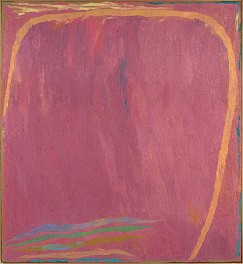
November 24, 2021 - Piri Halsz
Though I've reviewed the paintings of Stanley Boxer (1926 – 2000) many times, mostly it has been his work from the '80s and '90s that I discussed, the pictures covered with glittering, glistering accretions of matière. Only occasionally have I glanced at let alone reviewed his work from the early 1970s, but these are the paintings now featured in "Stanley Boxer: The Ribbon Paintings (1971- 1976)" at Berry Campbell in Chelsea (through December 23). And they form a wonderful chapter in pure painting.
Born in Williamsburg, Brooklyn, Boxer served in the U.S. Navy during World War II, and then studied art at the Art Students League on the G. I. Bill of Rights. He exhibited at various Manhattan galleries from 1953 onward. Still, it doesn't seem to have been until he arrived at Tibor de Nagy in 1971 that some observers began calling him a color-field painter (a designation he always denied, scorning affiliation with any group at all).
According to the brochure essay to the present show by Lisa N. Peters, immediately before 1971, Boxer had been making collages with strips of canvas. A half-way stage may be seen in two of the earlier pictures in this show, most notably "Willowsnowpond" (1972). This good-sized horizontal oil on linen depicts a few totally opaque matte bands of beige wiggling across the perimeters of an equally opaque matte field of dark brown.
Still, other paintings done earlier already boast of more transparent --- and painterly -- layers of paint. "Warmfield" (1971), another and larger square oil on linen, has just such a luminous field of medium green, near whose perimeters stroll vertical arched bands of mustard, olive – and a horizontal one of mauve.
There is something very friendly about these paintings: they do not insist; they invite. And particularly this may be seen by the latest and often largest paintings ranged at the front of the gallery and hung near its entrance, with their loose and ever-more-transparent fields of paint.
To be honest, the subtlety of the brushwork in this series of paintings makes them particularly difficult to appreciate in reproduction. However, the range of tonalities can at least be listed by this correspondent in three cases.
First is the "overmantel" hung above the reception desk. It is titled (in Boxer's characteristic seriocomic portmanteau style) "Seagustglories" (1974), and is a horizontal oil on linen with three horizontal bands, respectively of ocher, lime and mint.
Second is the very tall and narrow "Sunbraid" (1973), also an oil on linen (though there are a few oils on canvas in this show). Hung in the first main gallery space, with its back to the reception desk, "Sunbraid" has a field of mixed orange and lime, upon which is superimposed a soaring, narrow vertical black wiggly line that makes me think of a bird in flight.
Finally and most impressively is "Rainnights" (1973), a large, nearly square vertical oil on linen whose field is a wonderfully mottled raspberry ice. Arched over this field on the top and right-hand side of the canvas wanders a long orange line, while anchoring down the lower left corner are a few short horizontal lines like twigs in cool blues and greens.
If this isn't a very fresh and different kind of color-field painting, it's a kissing cousin to it – so affectionate it is.
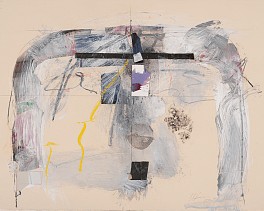
November 19, 2021 - Parrish Art Museum, Water Mill, New York
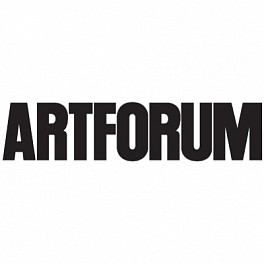
November 10, 2021 - Artforum
Anonymous Was a Woman (AWAW), a New York–based organization that for two decades has sought to support women-identifying artists over forty, has announced the winners of its 2021 grants. Owing to a dramatic increase in funding provided by two anonymous donors, AWAW is able to provide a dozen more of the unrestricted $25,000 grants than originally expected; the $300,000 windfall will be divided among four artists annually for the next three years, meaning that the group is able to award grants to fourteen winners annually through 2023, rather than the typical ten. Artnews reports that one of the s donations was made through the newly established Meraki Artist Award, founded by an anonymous Boston-based philanthropist.
“I am delighted to congratulate this year’s award recipients—a group of extraordinary artists who represent a multitude of viewpoints, backgrounds, and formal practices,” said founder Susan Unterberg said. “When I started Anonymous Was A Woman, I did so to address a need that I felt personally as a woman artist in the middle of her career. I never dreamed that it could inspire other individuals to join us in advancing our mission.”
Artists were chosen from applicants anonymously recommended by a group of art historians curators, writers, and artists. Among the recipients this year are interdisciplinary artist and activist Coco Fusco, sculptor Anna Sew Hoy, Lakota painter Dyani White Hawk, and light artist Marian Zazeela, a cofounder with LaMonte Young of New York’s Dream House.
Anonymous Was a Woman was established in 1996 by Unterberg, an artist, who initially served as its sole funder; it gained widespread attention in 2018 when she revealed herself as its founder. The organization’s grants are unique in that they are awarded to midcareer artists, many of whom are underrecognized. Though the sum awarded is modest, an AWAW grant can provide a career boost at a critical juncture. Many recipients of the award have gone on to gain greater recognition.
The full list of 2021 recipients is below.
Nanette Carter
Oletha DeVane
Adama Delphine Fawundu
Anita Fields
Coco Fusco
Renée Green
Judithe Hernández
Suzanne Jackson
Autumn Knight
Adia Millett
Anna Sew Hoy
Julie Tolentino
Dyani White Hawk
Marian Zazeela

November 9, 2021 - Tessa Solomon for ARTnews
The New York–based organization Anonymous Was a Woman has revealed the winners of its 2021 awards, each of which carries a $25,000 purse. For two decades, the awards have been given annually to women-identifying artists over the age of 40.
Now, for the first time, Anonymous Was a Woman is dramatically growing its program. Thanks to two anonymous donors, the organization will give out an additional $300,000 in funding to 12 artists. Through the donors’ gifts—one of which was made through the Meraki Artist Award, a new initiative from an anonymous Boston-based philanthropist—the awards program will be able to recognize four more artists annually for the next three years, bringing the total amount of people recognized to 14 instead of the typical 10.
The 2021 awardees range in age from 41 to 81, and include Nanette Carter, a New York–based educator and mixed media artist known for her abstract paintings on sheaths of frosted Mylar; Anita Fields, a ceramic and textile artist of Osage heritage; and Suzanne Jackson, a visual artist and poet, and director of the now-defunct Gallery 32, one of the first commercial spaces to promote emerging African American artists in Los Angeles in the late 1960s. Also awarded is performance artist, dancer, and activist Julie Tolentino, who last year received Queer|Art’s annual $10,000 award for Sustained Achievement.
“It is an unexpected honor to finally receive recognition for my work as a painter and sculptor,” Jackson told ARTnews. “I have known about the Anonymous Was A Woman award for years, though I never thought that I would be a recipient. I plan to use the award funds to continue my work exploring new aspects of integrating drawing, painting, and sculptured forms as related to various American relationships to our natural and urban environments.” Continue Reading

November 9, 2021 - Sarah Cascone for Artnet News
The award will give out an additional $300,000 over the next three years thanks to an anonymous donation.
The Anonymous Was a Woman awards are back and better than ever, thanks to new donations—made anonymously, naturally—that will expand the number of annual honorees from 10 to 14 for the next three years. That increases the total amount of grant money to $350,000 each year, with each recipient receiving $25,000 in unrestricted funds.
Since 1996, the organization has presented grants to women-identifying artists over the age of 40, a segment that is frequently overlooked by both the market and museums. Founder Susan Unterberg, an artist herself, only revealed her identity in 2018. The additional funding comes from two donors, one of which is a Boston-based philanthropist who made the gift through a new initiative called the Meraki Artist Award, according to ARTnews.
The 2021 winners, who are between the ages of 41 and 81, are: Nanette Carter, Oletha DeVane, Adama Delphine Fawundu, Anita Fields, Coco Fusco, Renée Green, Judithe Hernández, Suzanne Jackson, Autumn Knight, Adia Millett, Anna Sew Hoy, Julie Tolentino, Dyani White Hawk, and Marian Zazeela.
“I am delighted to congratulate this year’s award recipients—a group of extraordinary artists who represent a multitude of viewpoints, backgrounds, and formal practices,” Unterberg said in a statement. “When I started Anonymous Was A Woman, I did so to address a need that I felt personally as a woman artist in the middle of her career. I never dreamed that it could inspire other individuals to join us in advancing our mission.” Continue Reading


October 26, 2021 - Alina Tugend for The New York Times
The work and struggle by Jamel Robinson and other artists is part of the “African American Art in the 20th Century” exhibition at the Hudson River Museum.
“Fighting for Change: Fist Full of Tears,” the title of one of the five works Jamel Robinson is showing at the Hudson River Museum in Yonkers, N.Y., encapsulates the artist’s love of wordplay as well as philosophy about what it means to be a Black man making art in America.
The piece is a pair of boxing gloves covered in black paint and pennies mounted on a large black, green and white canvas.
“As Black people we’re fighting for change, and as a Black artist, we’re always trying to move forward — it always feels like we’re fighting for change and sometimes literally for change,” said Mr. Robinson, 42, who was born and raised in Harlem.
He is the teaching artist-in-residence at the museum in conjunction with the “African American Art in the 20th Century” exhibition, which includes 43 works by some of the country’s most famous Black artists. Mr. Robinson’s first museum show and the 20th Century exhibition will run concurrently from Oct. 15 through Jan. 16. Continue Reading